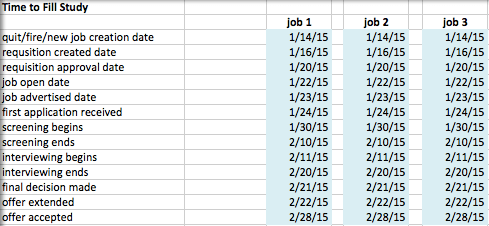
How to Explain Time to Fill to Your Executive Team
Measuring time to fill, or time to hire, is an important way for recruiters to demonstrate their efficiency. The longer a position goes unfilled, the more productivity will be disrupted, and the more the burden of that job will fall to someone else. By accurately measuring time to fill, HR leaders can evaluate the speed of their recruitment processes, and provide fellow managers with realistic time frames for their vacant positions. These simple metrics can be incredibly useful if used correctly. Before you become frustrated, take a step back to understand the disconnect between the HR function and C-suite objectives. In order to yield the best results, you’ll have to learn to speak on TTF in executive speak. Here’s a comprehensive way to explain and calculate TTF to your executive team.
Before you become frustrated, take a step back to understand the disconnect between the HR function and C-suite objectives
Time to Fill Definition
Simply put, time to fill is a measurement HR professionals use as a method to track hiring efficiency. Keep in mind that TTF needs to be balanced with cost and quality hiring measures. Otherwise, recruiters could be detrimental to the hiring process. Time to fill can provide valuable feedback in determining which sourcing methods and recruitment strategies can most quickly produce the needed candidates, to be used in the future. Recruiters and organizations can significantly reduce the cost of vacancies in jobs by driving down the time it takes to fill a job.Track your Source of Hires today!
Download our Source of Hires Cheat Sheet that will walk you through the steps you need to gain a better perspective of where your best Source of Hires are.
Traditional Approach: Time to Fill Calculation
Traditional time-to-fill is measured by calculating the number of days from when the job requisition was received (RR) until the offer was accepted by the candidate (AD) for each job filled during the measurement period. If you choose to calculate this way, make sure to calculate all positions filled— both with internal and external candidates.The number of days open is calculated using calendar days, including weekends and holidays. Combine the total number of calendar days that your total number of vacant jobs were open and then divide by the number of positions filled during the time period which will provide an average that balances seasonal and other fluctuations.
Different Approach: What you have been missing.
Now, this is only one way of looking at time to fill and this way of calculating it, I believe, is a very short-sided view of it. A position is open when someone quits, is fired, or a new job is created. Yet, when we talk to people as we are speaking at events across the country and in webinars, the most common start date on time to fill is once the requisition is approved. Why is this? Isn’t the organization loosing money and productivity when there isn’t a person in that seat working each day? The answer is yes. As an organization, productivity is suffering each day that seat sits empty. As we have asked this in our speaking events, we have found that HR has little to do with many of the pieces that go into the start to finish approach. For example, HR has little control over when a requisition is initiated and approved. Most of the time, the HR recruiting responsibilities begin after the requisition is approved. Yet many times, HR is the owner and calculator of time to fill. So, they don’t want to look bad and have that number be higher than it needs to be. Ok. This is sound logic. I get it. However, if we are trying to be strategic HR professions that have a seat at the table and contribute in a positive way to the overall organization and goals, this is the wrong way to approach it. We need to be proactive, organization minded, and revenue focused. So, how do we do that with time to fill? Well, first you download our time to fill calculator and downloadable template and then you get to work. Each day that an event happens in the life of the job opening, it should be tracked. Here is a list of those dates that I think you should be tracking:
Our time to fill calculator then takes these dates and makes calculations based on the time between dates. Again go download the fill to see how the calculator works. I believe that you should be calculating at least 5 key metrics on time to fill: Overall time (in days), Requisition Time, Sourcing Time, Screening and Selection Time, and Decision Time. Each one of these potentially could involve different individuals and each holds some responsibility to speed up the process. Keeping track of these metrics with every job will allow you to identify where there is breakdown in the process and to be able to make improvements and to communicate to your C-Suite your part in the process.
Use the time to fill calculator to help executives understand the impact of your process.
How to Explain to Your Organization’s Leaders
Time to fill can only be properly executed if the quality of recruitment is there. While filling roles quickly is a priority, the quality of the new hire has to be taken into consideration. In fact, 27% of the U.S. employers surveyed in a recent Career Builder study, said that just one of these bad hires cost their company more than $50,000. As a member of the HR function, TTF makes sense from the human perspective. To help executives understand the process, rely on the TTF calculator so that they can understand the financial impact of each step in your process.

Get started tracking your Source of Hires today!
Download our Source of Hires Cheat Sheet that will walk you through the steps you need to gain a better perspective of where your best Source of Hires are.
Share this article
Related Articles

Mastering the Interview Process: Tips for Efficient and Effective Hiring
Learn how to conduct efficient interviews! Discover tips on clear objectives, engaging questions, creating a welcoming environment, behavioral observation, and leveraging video interviewing tools. Master the art of interviewing to enhance your hiring process!

Revolutionize Your Payroll Experience
Elevate your payroll management with ApplicantPro Payroll. Say goodbye to mediocrity and embrace a customizable platform tailored to your business needs. Our unparalleled customer service ensures you're never alone in managing payroll.

What's the secret to minimizing employee turnover?
From perks and transparency to strategic training, learn how to minimize turnover woes and achieve your hiring goals. Say goodbye to hiring headaches and hello to a low-turnover future!